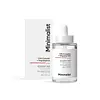Minimalist CPH Complex + Oligopeptide 0.8% Anti-Dandruff Serum Versus Kérastase Genesis Anti Hair-Fall Fortifying Serum
What's inside
What's inside
 Key Ingredients
Key Ingredients

 Benefits
Benefits

 Concerns
Concerns

 Ingredients Side-by-side
Ingredients Side-by-side

Propylene Glycol
HumectantGlycerin
HumectantPEG-12 Dimethicone
Skin ConditioningXylitylglucoside
HumectantSalicylic Acid
MaskingEthyl Lauroyl Arginate Hcl
Skin ConditioningPanthenol
Skin ConditioningPiroctone Olamine
PreservativeClimbazole
AntimicrobialHexamidine Diisethionate
EmollientOligopeptide-29
AntioxidantPropanediol Caprylate
Skin ConditioningWater
Skin ConditioningHexylene Glycol
EmulsifyingCapryloyl Glycine
CleansingPhenoxyethanol
PreservativeAnhydroxylitol
HumectantXylitol
HumectantEthylhexylglycerin
Skin ConditioningPropylene Glycol, Glycerin, PEG-12 Dimethicone, Xylitylglucoside, Salicylic Acid, Ethyl Lauroyl Arginate Hcl, Panthenol, Piroctone Olamine, Climbazole, Hexamidine Diisethionate, Oligopeptide-29, Propanediol Caprylate, Water, Hexylene Glycol, Capryloyl Glycine, Phenoxyethanol, Anhydroxylitol, Xylitol, Ethylhexylglycerin
Water
Skin ConditioningAlcohol Denat.
AntimicrobialDiaminopyrimidine Oxide
Skin ConditioningAmmonium Polyacryloyldimethyl Taurate
Emulsion StabilisingAminomethyl Propanol
BufferingCitric Acid
BufferingPEG-40 Hydrogenated Castor Oil
EmulsifyingPiroctone Olamine
PreservativeCaffeine
Skin ConditioningArginine
MaskingLimonene
PerfumingNiacinamide
SmoothingPyridoxine Hcl
Skin ConditioningLinalool
PerfumingSafflower Glucoside
Benzyl Salicylate
PerfumingCoumarin
PerfumingCitral
PerfumingBenzyl Alcohol
PerfumingXylitylglucoside
HumectantCitronellol
PerfumingBenzyl Benzoate
AntimicrobialAnhydroxylitol
HumectantXylitol
HumectantZingiber Officinale Root Extract
MaskingResveratrol
AntioxidantTocopherol
AntioxidantBHT
AntioxidantSodium Citrate
BufferingParfum
MaskingWater, Alcohol Denat., Diaminopyrimidine Oxide, Ammonium Polyacryloyldimethyl Taurate, Aminomethyl Propanol, Citric Acid, PEG-40 Hydrogenated Castor Oil, Piroctone Olamine, Caffeine, Arginine, Limonene, Niacinamide, Pyridoxine Hcl, Linalool, Safflower Glucoside, Benzyl Salicylate, Coumarin, Citral, Benzyl Alcohol, Xylitylglucoside, Citronellol, Benzyl Benzoate, Anhydroxylitol, Xylitol, Zingiber Officinale Root Extract, Resveratrol, Tocopherol, BHT, Sodium Citrate, Parfum
Ingredients Explained
These ingredients are found in both products.
Ingredients higher up in an ingredient list are typically present in a larger amount.
This ingredient is created from dehydrating xylitol in acidic conditions. Xylitol is a famous sugar and humectant.
Much like its predecessor, anhydroxylitol is a humectant. Humectants attract and hold water to moisturize the skin.
This ingredient is most commonly found in a popular trio called Aquaxyl. Aquaxyl is made up of anhydroxylitol (24 - 34%), xylitylglucoside (35 - 50%), and xylitol (5 - 15%).
According to a manufacturer, Aquaxyl is known for a 3-D hydration concept and an anti-dehydration shield to reinforce the outer layer of skin.
This ingredient is often derived from plants such as wood and sugarcane.
Learn more about AnhydroxylitolPiroctone Olamine is used to treat fungal infections and often found in anti-dandruff shampoo.
This ingredient is particularly effective against Malassezia, the root cause of dandruff.
Piroctone olamine is water-soluble.
Learn more about Piroctone OlamineWater. It's the most common cosmetic ingredient of all. You'll usually see it at the top of ingredient lists, meaning that it makes up the largest part of the product.
So why is it so popular? Water most often acts as a solvent - this means that it helps dissolve other ingredients into the formulation.
You'll also recognize water as that liquid we all need to stay alive. If you see this, drink a glass of water. Stay hydrated!
Learn more about WaterXylitol is a humectant and prebiotic. It can help with dry skin.
In studies, xylitol has been shown to improve dry skin. It decreased transepidermal water loss, or when water passes through the skin and evaporates. Xylitol also showed to help improve the biomechanical properties of the skin barrier.
The prebiotic property of xylitol may also help reinforce our skin's natural microbiome. Having a healthy microbiome prevents infection by bad bacteria and helps with hydration.
As a humectant, Xylitol helps draw moisture from both the air and from deeper skin layers. This helps keep skin hydrated.
Xylitol is a sugar alcohol and commonly used as a sugar substitute. It is naturally occurring in plants such as strawberries and pumpkin.
Learn more about XylitolXylitylglucoside is created from xylitol and glucose, two humectants.
Not surprisingly, this ingredient is also a humectant. It attracts and holds water in your skin, helping to maintain hydration.
This ingredient is most commonly found in a popular trio called Aquaxyl. Aquaxyl is made up of anhydroxylitol(24 - 34%), xylitylglucoside (35 - 50%), and xylitol (5 - 15%).
According to a manufacturer, Aquaxyl is known for a 3-D hydration concept and an anti-dehydration shield to reinforce the outer layer of skin.
Learn more about Xylitylglucoside